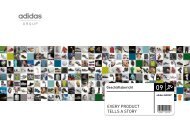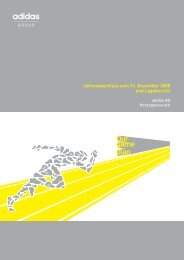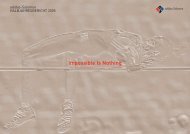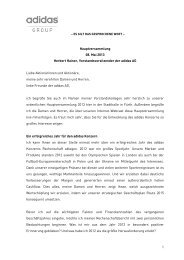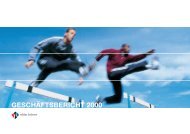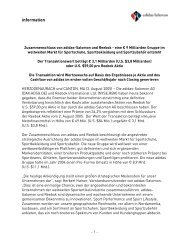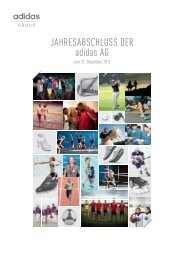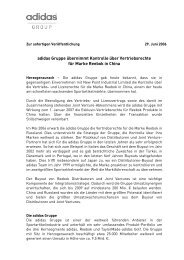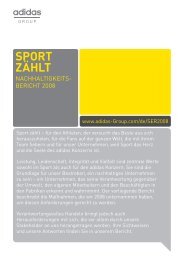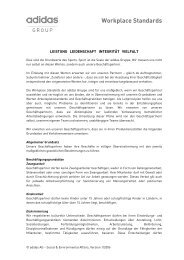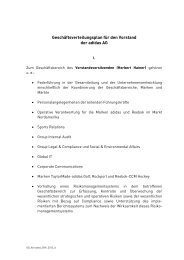Environment PDF - adidas Group
Environment PDF - adidas Group
Environment PDF - adidas Group
Create successful ePaper yourself
Turn your PDF publications into a flip-book with our unique Google optimized e-Paper software.
eNVIRONmeNTAL KpI<br />
With the rollout of the environmental Sourcing Strategy<br />
(eSS), we required a tool to provide a systematic way of<br />
assessing and ranking our suppliers. So we developed an<br />
environmental Key performance Indicator (KpI) tool.<br />
The environmental KpI is comprised of three key units of<br />
measure – management systems, risk and performance – all<br />
key drivers of our eSS. each section is given a score which is<br />
then weighted to give a total score out of 100.<br />
All factories will undergo a pre-screening process through<br />
which they will be classified as high, medium or low-risk.<br />
High-risk factories will be subject to an environmental<br />
assessment during which the auditor will also complete the<br />
environmental KpI. Unless otherwise warranted, for those<br />
factories which are categorised as medium to low-risk, the<br />
environmental KpI will be conducted as a desktop exercise<br />
supplemented by inputs from SeA’s performance Audit and<br />
Compliance KpI results. Like the SeA Social Compliance KpI,<br />
the SeA environmental KpI score for each factory will be<br />
reviewed annually and reported to Sourcing. They will then<br />
use it as part of their overall assessment of the supplier’s<br />
performance.<br />
The pilot testing of the environmental KpI tool began in late<br />
2010 and will be completed within the first quarter of 2011<br />
with planned full implementation by mid 2011.<br />
TRAINING SUPPLIERS<br />
In 2010, we further tailored our training programmes on<br />
environmental issues. primary focus was on trainings<br />
related to management systems for material suppliers<br />
as well as preparatory steps for the development of a<br />
sustainable manufacturing programme.<br />
mANAgemeNT SYSTemS TRAININg<br />
fOR mATeRIAL SUppLIeRS<br />
In 2010, the SeA team undertook a detailed examination of<br />
the environmental risk of Tier 2 material suppliers (fabric<br />
mills and dye houses) as part of the Risk management<br />
profiling under the environmental Sourcing Strategy. during<br />
the course of the audits, it became clear that many of the<br />
suppliers lacked the knowledge and skills to implement<br />
the ISO 14001 environmental management system and the<br />
OHSAS 18001 occupational health and safety management<br />
system. In many cases, the lack of structured systems<br />
resulted in the poor management of environmental, health<br />
and safety issues at these facilities.<br />
AN INTROdUCTION TO mANAgemeNT SYSTemS<br />
In response, we organised a one-day introductory seminar<br />
focusing on ISO 14001 and OHSAS 18001 for our key Tier<br />
2 fabric mill suppliers in August 2010 in Taipei, Taiwan.<br />
The seminar was conducted in Chinese by an external<br />
professional member of the Taiwan Industry Service<br />
foundation. In total, 43 participants attended, representing<br />
17 suppliers.<br />
01 ABOUT OUR pROgRAmme<br />
17 eNVIRONmeNT<br />
41 SUppLIeRS<br />
57 empLOYeeS<br />
64 COmmUNITY<br />
72 peRfORmANCe<br />
102 gRI INdex<br />
The key topics covered included:<br />
• elements of the ISO 14001 and OHSAS 18001<br />
management systems<br />
• How to implement the systems in a factory setting<br />
• Required resources (manpower, cost, time)<br />
• An introduction to the consultancies that can assist in<br />
establishing systems and certification bodies.<br />
LeARNINg BY dOINg<br />
during the workshop, participants were separated<br />
into smaller working groups to discuss the potential<br />
environmental impacts and health and safety risks within a<br />
major dyeing process area. This enabled the participants to<br />
practice the principles they had been trained on earlier in the<br />
day. The day went well with participants expressing a 95%<br />
satisfaction level with the workshop.<br />
To consolidate their learning, participants were set a mini<br />
assignment as homework:<br />
• To complete an organisation chart outlining key roles and<br />
responsibilities<br />
• To establish key objectives and set targets<br />
• To prepare a legal list review (related specifically to<br />
environmental and safety health aspects).<br />
All of the suppliers completed and submitted their<br />
assignments on time, and we are hopeful they will go on to<br />
implement the management systems in their factories.<br />
SUSTAINABLe mANUfACTURINg<br />
TRAININg pROgRAmme<br />
The <strong>adidas</strong> group has recently commissioned the Royal<br />
melbourne Institute of Technology University (RmIT) to<br />
undertake a research study to identify the opportunities<br />
and barriers to establishing a regional Sustainable<br />
manufacturing Training programme for the footwear and<br />
garment industry in Asia. The research is to run integrated<br />
with the <strong>adidas</strong> group’s internal environmental Strategy<br />
and environmental supply chain auditing initiatives and our<br />
planned production for the London 2012 Olympic games, the<br />
world’s first sustainable Olympic games.<br />
RmIT has been retained to advise on the best institutional<br />
arrangement to build supply chain capacity and strengthen<br />
factory-level capabilities in the fields of sustainable<br />
manufacturing and resource efficiency. The research<br />
institute will also define possible opportunities for<br />
collaboration across the industry, with other multinationals<br />
and with local manufacturing associations. It will also look at<br />
the possible benefits of forming public-private partnerships<br />
with national governments, or international agencies.<br />
The researchers will map out existing opportunities and<br />
training initiatives and build on these, to help drive closer<br />
collaboration and improved performance across the broader<br />
supply chain, from raw material sourcing, through subcomponents,<br />
to finished goods. The results of the first phase<br />
of the research will be made available for industry comment<br />
at the end of 2011.<br />
IN THE REAL WORLD PERFORMANCE COUNTS Sustainability Report 2010<br />
34



